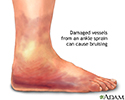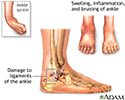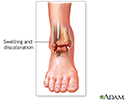Ankle pain
Pain - ankle
Ankle pain involves any discomfort in one or both ankles.
Causes
Ankle pain is often due to an ankle sprain.
-
An
ankle sprain
is an injury to the ligaments, which connect bones to one another.
Ankle sprain
Lateral ankle sprain - aftercare; Medial ankle sprain - aftercare; Medial ankle injury - aftercare; Ankle syndesmosis sprain - aftercare; Syndesmosis...
Read Article Now Book Mark Article - In most cases, the ankle is twisted inward, causing small tears in the ligaments. The tearing leads to swelling and bruising, making it difficult to bear weight on the joint.
In addition to ankle sprains, ankle pain can be caused by:
- Damage or swelling of tendons (which join muscles to bone) or cartilage (which cushions joints)
-
Infection in the ankle joint
Infection in the ankle joint
Septic arthritis is inflammation of a joint due to a bacterial or fungal infection. Septic arthritis that is due to the bacteria that cause gonorrhe...
Read Article Now Book Mark Article -
Osteoarthritis
,
gout
,
rheumatoid arthritis
,
Reiter syndrome
, and other types of arthritis
Osteoarthritis
Osteoarthritis (OA) is the most common joint disorder. It is due to aging and wear and tear on a joint.
 ImageRead Article Now Book Mark Article
ImageRead Article Now Book Mark ArticleGout
Gout is a type of arthritis. It occurs when uric acid builds up in blood and causes inflammation in the joints. Acute gout is a painful condition th...
 ImageRead Article Now Book Mark Article
ImageRead Article Now Book Mark ArticleRheumatoid arthritis
Rheumatoid arthritis (RA) is a long-term disease. It leads to inflammation of the joints and surrounding tissues. It can also affect other organs....
 ImageRead Article Now Book Mark Article
ImageRead Article Now Book Mark ArticleReiter syndrome
Reactive arthritis is a group of conditions that may involve the joints, eyes, and urinary and genital systems. These areas become swollen and infla...
 ImageRead Article Now Book Mark Article
ImageRead Article Now Book Mark Article
Problems in areas near the ankle that can cause you to feel pain in the ankle include:
- Blockage of blood vessels in the leg
- Heel pain or injuries
-
Nerve injuries (such as tarsal tunnel syndrome or
sciatica
)
Sciatica
Sciatica refers to pain, weakness, numbness, or tingling in the leg. It is caused by injury to or pressure on the sciatic nerve. Sciatica is a symp...
 ImageRead Article Now Book Mark Article
ImageRead Article Now Book Mark Article
Home Care
Home care for ankle pain depends on the cause and what other treatment or surgery has taken place. You may be asked to:
- Rest your ankle for several days. Try to NOT put much weight on your ankle.
- Put on an ACE bandage. You also can buy a brace that supports your ankle.
- Use crutches or a cane to help take the weight off a sore or unsteady ankle.
- Keep your foot raised above the level of your heart. When you are sitting or sleeping, place two pillows under your ankle.
- Ice the area right away. Apply ice for 10 to 15 minutes every hour for the first day. Then, apply ice every 3 to 4 hours for 2 more days.
-
Try acetaminophen, ibuprofen, or other
pain relievers
made by the store.
Pain relievers
Over-the-counter (OTC) pain relievers can help relieve pain or lower a fever. Over-the-counter means you can buy these medicines without a prescript...
 ImageRead Article Now Book Mark Article
ImageRead Article Now Book Mark Article
As the swelling and pain improve, you may still need to keep extra weight stress off your ankle for a period of time.
The injury may take a few weeks to many months to fully heal. Once the pain and swelling are mostly gone, the injured ankle will still be a little weaker and less stable than the uninjured ankle.
- You will need to start exercises to strengthen your ankle and avoid injury in the future.
- DO NOT begin these exercises until a health care professional tells you it is safe to start.
- You will also need to work on your balance and agility.
Other advice your health care provider may give you include:
- Lose weight if you are overweight. Extra weight puts strain on your ankles.
- Warm up before exercising. Stretch the muscles and tendons that support the ankle.
- Avoid sports and activities for which you are not properly conditioned.
- Make sure that shoes fit you properly. Avoid high-heeled shoes.
- If you are prone to ankle pain or twisting your ankle during certain activities, use ankle support braces. These include air casts, ACE bandages, or lace-up ankle supports.
- Work on your balance and do agility exercises.
When to Contact a Medical Professional
Go to the hospital if:
- You have severe pain even when you are NOT bearing weight.
- You suspect a broken bone (the joint looks deformed and you cannot put any weight on the leg).
- You can hear a popping sound and have immediate pain of the joint.
Call your health care provider if:
- Swelling does not go down within 2 to 3 days
- You have symptoms of infection. The area becomes red, more painful, or warm, or you have a fever over 100°F (37.7°C)
- The pain does not go away after several weeks
- Other joints are also involved
- You have a history of arthritis and are having new symptoms
References
Abu-Laban RV, Rose NGW. Ankle and foot. In: Marx JA, Hockberger RS, Walls RM, et al, eds. Rosen's Emergency Medicine: Concepts and Clinical Practice . 8th ed. Philadelphia, PA: Elsevier Mosby; 2013:chap 58.
Irwin TA. Tendon injuries of the foot and ankle. In: Miller MD, Thompson SR, eds. DeLee and Drez's Orthopaedic Sports Medicine . 4th ed. Philadelphia, PA: Elsevier Saunders; 2015:chap 117.
Molloy A, Selvan D. Ligamentous injuries of the foot and ankle. In: Miller MD, Thompson SR, eds. DeLee and Drez's Orthopaedic Sports Medicine . 4th ed. Philadelphia, PA: Elsevier Saunders; 2015:chap 116.
Osborne MD and Esser SM. Chronic ankle instability. In: Frontera, WR, Silver JK, Rizzo TD, eds. Essentials of Physical Medicine and Rehabilitation . 3rd ed. Philadelphia, PA: Elsevier Saunders; 2015:chap 85.
Price MD, Chiodo CP. Foot and ankle pain. In: Firestein GS, Budd RC, Harris ED Jr, et al, eds. Kelley's Textbook of Rheumatology . 9th ed. Philadelphia, PA: Elsevier Saunders; 2012:chap 49.
-
Ankle sprain swelling - illustration
Mild to severe swelling and bruising can accompany a sprain to the ankle. Bruising usually indicates tearing of ligament tissue and a more severe sprain.
Ankle sprain swelling
illustration
-
Ankle sprain - illustration
An ankle sprain is a common injury to the ankle. The most common way the ankle is injured is when the ankle is twisted inward (inversion injury). With this injury, ligaments that support the ankle can be torn which lead to swelling, inflammation, and bruising around the ankle. An ankle sprain injury may take a few weeks to many months to fully heal.
Ankle sprain
illustration
-
Sprained ankle - illustration
A sprain is caused by the twisting or bending of a joint into a position it was not designed to move. The ankle is the most commonly sprained joint. Some common symptoms of a sprain are pain around the joint, swelling, and bruising.
Sprained ankle
illustration
-
Ankle sprain swelling - illustration
Mild to severe swelling and bruising can accompany a sprain to the ankle. Bruising usually indicates tearing of ligament tissue and a more severe sprain.
Ankle sprain swelling
illustration
-
Ankle sprain - illustration
An ankle sprain is a common injury to the ankle. The most common way the ankle is injured is when the ankle is twisted inward (inversion injury). With this injury, ligaments that support the ankle can be torn which lead to swelling, inflammation, and bruising around the ankle. An ankle sprain injury may take a few weeks to many months to fully heal.
Ankle sprain
illustration
-
Sprained ankle - illustration
A sprain is caused by the twisting or bending of a joint into a position it was not designed to move. The ankle is the most commonly sprained joint. Some common symptoms of a sprain are pain around the joint, swelling, and bruising.
Sprained ankle
illustration
Review Date: 3/5/2015
Reviewed By: C. Benjamin Ma, MD, assistant professor, chief, sports medicine and shoulder service, UCSF Department of Orthopaedic Surgery, San Francisco, CA. Also reviewed by David Zieve, MD, MHA, Isla Ogilvie, PhD, and the A.D.A.M. Editorial team.



